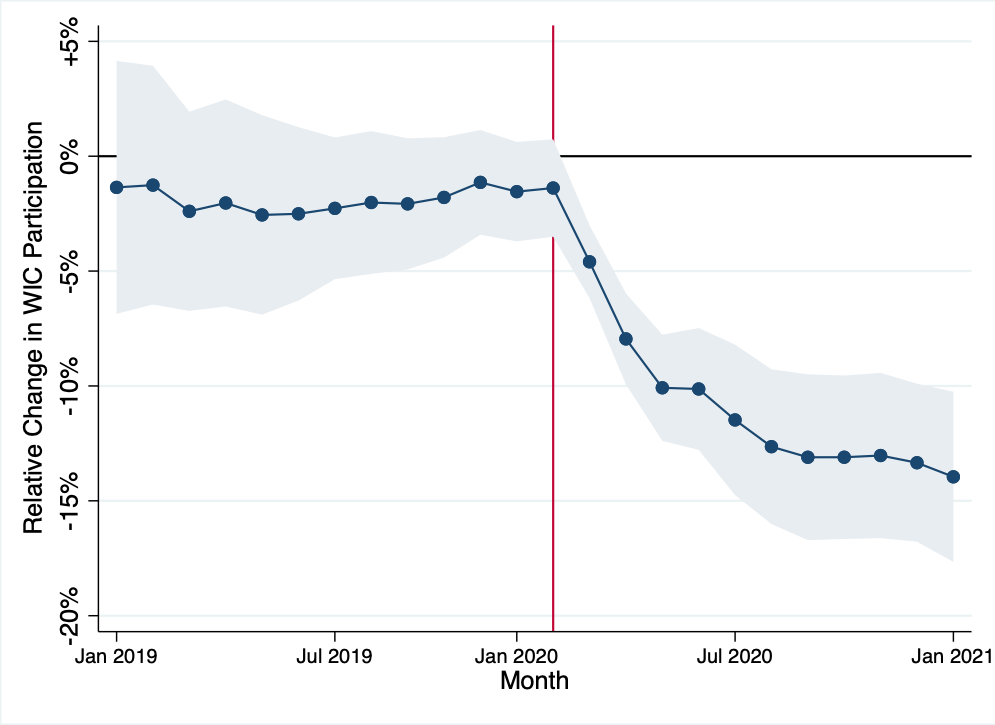The Impact of In-person Benefit Reloading on WIC Participation During the COVID-19 Pandemic
Editor’s Note: This blog post is a slightly edited version of the original that appeared on Penn’s Leonard Davis Institute of Health Economics’ blog.
Childhood hunger and food insecurity have risen dramatically in the U.S. during the COVID-19 pandemic and the subsequent economic recession. Since March 2020, 1 in every 4 children has experienced household food insecurity, where their access to adequate nutrition was limited by their family’s financial resources.
The Special Supplemental Nutrition Program for Women, Infants, and Children, or WIC, provides nutritional support and nutrition education to food insecure children and families in poverty. WIC has proven health benefits for participating women and children, including lower rates of preterm birth, decreased food insecurity, and improved nutrition. However, prior to the pandemic, only about half of all eligible families received WIC benefits. One reason for these low participation rates is the administrative burden that families face when enrolling in WIC and accessing and redeeming benefits.
In a recent study in JAMA, we examined one way in which these burdens may have worsened during the COVID-19 pandemic. Participating families receive electronic benefits transfer (EBT) debit cards, which they can use to purchase approved food and beverage products from vendors that accept WIC benefits. Nine “offline EBT” states (Arkansas, Louisiana, New Mexico, Missouri, Ohio, Pennsylvania, Utah, Texas, and Wyoming) currently require WIC beneficiaries to present these cards in-person at their local WIC office every 3-4 months to reload their benefits. In all other states, WIC EBT cards are automatically reloaded online (remotely) each month, and beneficiaries do not have to travel to WIC clinics in-person during the pandemic.
We were interested in studying whether offline EBT reloading may have limited access to benefits during the pandemic, when eligible families may have needed them most. To estimate this, we compared WIC participation before and during the pandemic in online and offline EBT states. Prior to the pandemic, WIC participation declined in both online and offline states; during the pandemic, however, WIC participation increased sharply in online EBT states while it continued to decline in offline EBT states (Figure 1).

Figure 1: Unadjusted trends in WIC participation rates in Online and Offline EBT states from January 2019 to January 2021 are shown above. Participation rates were calculated by dividing the number of WIC participants in online and offline states during each month by the total number of WIC-eligible residents in these states in 2018, as WIC eligibility information from 2019-2021 was not available.
Over the first nine months of the pandemic, states with offline EBT experienced a 9.2% decrease in participation, relative to online EBT states. As of January 2021, we estimate that WIC participation was 14% lower in offline states, relative to online states (Figure 2). This corresponds to an estimated 160,000 fewer beneficiaries in these nine states.

Figure 2: This figure shows our adjusted difference-in-differences estimates of the difference in WIC caseload between online EBT and offline EBT states, in the months before and after the start of the COVID-19 pandemic in March 2020. The shaded area represents the 95% confidence interval for these estimates. Prior to March 2020, there was no significant difference in WIC participation in online versus offline states, but beginning at the start of the pandemic, offline states experienced a significant relative decrease in participation. As of January 2021, WIC participation had decreased by 14% in offline EBT states, relative to online EBT states.
Policy Recommendations
Our findings show that administrative barriers to accessing vital safety net programs can significantly reduce participation. These results have important policy implications for the U.S. Department of Agriculture and for state-level administrators of WIC and other government benefit programs.
- Offline EBT states should immediately work towards adopting online benefits reloading systems. In the interim, they should allow participants to reload their EBT cards less frequently.
- Online EBT states should continue to offer remote certification and remote benefits reloading, as these flexibilities, along with increased need, may have driven the surge in participation that occurred during the pandemic.
- As outlined in PolicyLab at Children’s Hospital of Philadelphia’s recent memo to the U.S. Department of Agriculture, both online and offline EBT states should consider other ways to minimize administrative burden and streamline benefits enrollment, including:
- making permanent the COVID-19 waiver permitting remote certification through video WIC visits, to increase access for families with barriers to transportation.
- simplifying the WIC enrollment process for families already enrolled in SNAP, Medicaid, or other government benefit programs.
- streamlining data sharing between WIC offices and pediatric primary care providers, which could eliminate the need for families to visit a WIC office in person for hemoglobin or lead screening when a primary care provider has already conducted the screen.
- building on the success of the SNAP online purchasing pilot and allowing WIC beneficiaries to use their benefits to purchase WIC-approved goods online.
Collectively, these steps could help ensure that the WIC program, which is one of our most effective tools against early childhood hunger in the U.S., can continue to reach the children and families who need it most.
